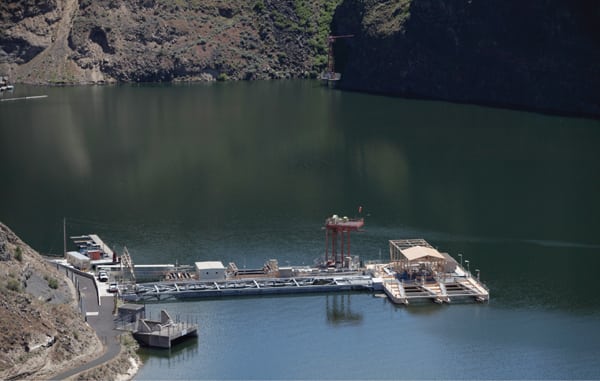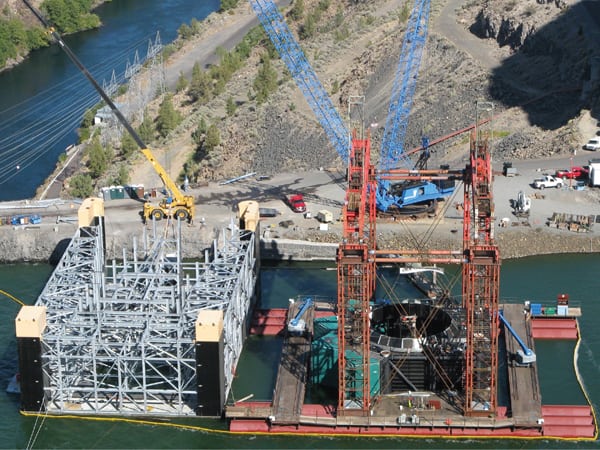Top Plant: Pelton Round Butte Hydroelectric Project’s Selective Water Withdrawal Project, Oregon
Owners: Portland General Electric and the Confederated Tribes of the Warm Springs Reservation of Oregon Operator: Portland General Electric
In December 2009, construction of an underwater tower and fish collection structure was successfully completed at the 465-MW Pelton Round Butte Hydroelectric Project. The first-of-its-kind fish bypass and intake structure returns temperatures in the lower Deschutes River to historic patterns and restores downstream passage of Chinook, steelhead, and sockeye salmon while maintaining existing generating capacity.
 |
| Courtesy: Portland General Electric |
Resting in a high desert setting in Central Oregon, Lake Billy Chinook is surrounded by high basalt cliffs and hillsides covered with sagebrush and juniper. The lake was formed by the construction of Round Butte Dam in 1964 and is fed by the Deschutes, Metolius, and Crooked Rivers. With its scenic views and large populations of bull trout and other fish species, the lake for years has attracted large numbers of anglers, boaters, hikers, and sightseers.
The new bypass and intake structure for the Pelton Round Butte Hydroelectric Project was one of the main components of a historic 50-year relicensing agreement signed in 2004 by co-owners Portland General Electric (PGE) and the Confederated Tribes of the Warm Springs Reservation of Oregon (CTWS), Steve Corson, spokesman for PGE, told POWER in October. A license with the U.S. Federal Energy Regulatory Commission (FERC) for the project was issued in 2005, incorporating the agreement. Officially known as the Selective Water Withdrawal Project (SWW), the structure is the world’s only known floating surface fish collection facility coupled with power generation (Figure 1). It was designed to reflect the latest scientific data about fish migration patterns. Construction wrapped up in 2009, and the project was certified as complete in early 2010.
 |
| 1. Award-winning design. The first-of-its-kind fish bypass and intake structure at the Pelton Round Butte Hydroelectric Project is shown while under construction. The Selective Water Withdrawal Project, which was designed and constructed by CH2M HILL, won the 2011 American Council of Engineering Companies’ national Grand Award. Courtesy: Portland General Electric |
Challenges with Original Fish Passage System
When the Round Butte dam was built in 1964, it had negative impacts on certain fish species in the area, even though it incorporated a juvenile and adult fish passage system. The original system included a downstream juvenile skimmer (capture facility) in the forebay of Round Butte Dam, an adult capture facility with associated upstream fish ladders, and a gondola that transported adult fish upstream over Round Butte Dam.
Unfortunately, the passage system failed, primarily due to downstream migration problems in Lake Billy Chinook, the reservoir behind Round Butte Dam. In 1966, when it was apparent that fish passage for downstream juvenile fish wasn’t functioning well, the system was abandoned. As a result of the failed fish passage system, Chinook, steelhead, and sockeye salmon were unable to make their migration to the Pacific Ocean, and their populations dwindled. Consequently, kokanee (landlocked sockeye salmon) and other non-migratory fish species ended up populating the reservoir.
A Unique Collaboration
The Pelton Round Butte Hydroelectric Project is the only U.S. hydroelectric project jointly owned by a Native American tribe and a utility. Currently, the project is two-thirds owned by PGE and one-third owned by the CTWS, through Warm Springs Power Enterprises. The uppermost dam is Round Butte; Pelton, the middle dam, forms Lake Simtustus; the lowermost dam, the re-regulating dam used to balance river flows to meet peak power demands, is owned by CTWS. The three-dam project has a total net capacity of 465 MW.
CTWS purchased their first interest in the hydroelectric project from PGE effective Jan. 1, 2002. They have the option to purchase additional interests up to a maximum of 50.01% as early as the year 2029, according to the ownership agreement. The re-regulating dam powerhouse remains wholly owned by the tribes.
While PGE and the CTWS had great confidence that the science behind the SWW project was sound, it required a significant commitment to environmental stewardship. At a cost of $108 million, and with no historical precedent to confirm that the system would successfully resolve migration problems, moving forward with the SWW represented a leap of faith.
As complicated and difficult as the engineering challenges of this project were, PGE and the CTWS faced an equally daunting task: obtaining support for this project from more than 22 stakeholder organizations and agencies with a diverse and sometimes competing range of objectives, including the National Marine Fisheries Service, the Oregon Department of Environmental Quality, the Oregon Department of Fish and Wildlife, and the U.S. Department of the Interior.
An Innovative Solution
Following issuance of the new license by FERC, the next challenge was for CH2M HILL, the company selected to handle the unprecedented engineering project, to take a concept to design, and ultimately to operation. The SWW and associated fish facilities at Round Butte Dam had to be designed to attract and capture migrating salmon, steelhead, and sockeye salmon. The fish then needed to be transported safely downstream.
In order for the SWW to achieve these goals, the project’s engineering team had to meet the following major objectives:
- Reorient the subtle surface currents toward the dam to allow downstream-migrating fish to find their way to the SWW.
- Safely capture downstream-migrating salmonids attempting to leave the reservoir using the SWW structure while excluding fish from the turbine intakes.
- Provide for the safe and efficient sorting, enumeration, tag detection, marking, and loading of downstream migrants for transport below the dam.
- Manage the downstream water quality during late summer and fall by mixing surface and deep waters to control the discharge temperature and dissolved oxygen levels mandated by the federal Clean Water Act.
- Meet seismic standards, as well as wind, wave, and hydraulic loading that an underwater structure is subject to.
- Achieve all of the above while maintaining hydroelectric generating capacity.
The size of the structure was driven by the location of the original powerhouse intake structure nearly 270 feet below the surface of the reservoir. This structure needed to be connected to the original intake structure to supply water for power generation while attracting fish and withdrawing water from the upper 40 feet of the reservoir. Adding to the challenge was the fact that the reservoir could not be drawn down to allow construction in a dry area and thereby required the assembly of components on site in a size-constrained construction area.
Construction of the 273-foot tall SWW tower was completed in December 2009. The bottom structure of the tower is coupled to the historic deep intake. The vertical flow conduit and top structure rises out of the bottom structure about 700 feet upstream of Round Butte Dam. It is capped with a rectangular-shaped intake structure that draws in generation water and fish.
Once the SWW tower became operational, it began collecting migrating fish. The fish are collected in two V-screens located on either side of the two intakes. The fish are then pumped to a fish-handling facility before being transported downstream of the project, where they can continue their migration to the Pacific Ocean. Water from the tower passes separately through turbines at the base of the dam to generate electricity.
Successful Results
Biologists predicted that, in the long term, at least 96% of the juvenile fish collected at the water withdrawal tower would be safely transported downstream of the project and, to date, those numbers have already been exceeded. In 2011, the first few adult salmon and steelhead began their return trip from the Pacific Ocean, up the Columbia and Deschutes Rivers.
The tower’s draw of warmer water off the surface of Lake Billy Chinook helps to keep the reservoir cooler in the summer, creating a healthier environment for fish. The tower has an intake near its bottom, so it can draw cold water during summer and fall to mix with warmer surface water. This helps maintain appropriate downstream temperatures in the lower Deschutes River. The modified reservoir environment provides a better habitat for bull trout, kokanee, and the rearing of juvenile sockeye salmon.
—Angela Neville, JD, is POWER’s senior editor.